Wedding Ring? or Single Wedding Ring?
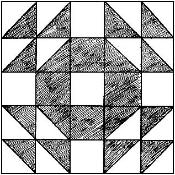
Wedding Ring, October 1, 1887, Farm and Home (Phelps, Springfield, MA), the earliest published engraving for this design that is presently known. Although it was called Saw Tooth in 1890 and again in 1894 and Odd Scraps Patchwork in 1895-1897, it continued to be identified as Wedding Ring in most publications for the next 41 years.
When did this design become the Single Wedding Ring?
Someone asked me this question several years ago and I was surprised by the answer when I looked in my database. It was April 12, 1930, in the Kansas City Star newspaper illustrated by Eveline Foland and has been generally known by this name ever since. As with many of our quilt designs, it picked up a few more names over the years, but has remained as Single Wedding Ring with most illustrators, columnists, and authors to this day.
Why the name change? Did the new popularity of the Double Wedding Ring play a role?
Double Wedding Ring
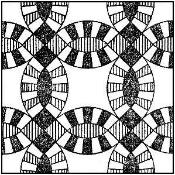
The Double Wedding Ring was first illustrated by Capper's Weekly (Arthur Capper, Topeka, KS), October 20, 1928: "When some good but unknown man conceived the idea of a double wedding ring ceremony it gave his wife an equally good idea. She worked the two circles into a double wedding ring quilt. There are folks who call this pattern "The Endless Chain" or "The Rainbow" and certainly it is an excellent way to use up endless scraps in rainbow shades. Capper's Weekly and her quilting fans are indebted to Mrs. J. D. Patterson of Wellington, Kan., for the design. If you wish an actual size cutting pattern of it, send 15 cents to Quilt Block Service, Capper's Weekly, Topeka, Kan. It will save you much time and bother, for the pattern gives the actual size of each piece and shows how they are set together."
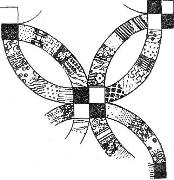
Just eleven days later, Ruby Short McKim's Wedding Ring was published in the Weekly Kansas City Star, October 31, 1928, followed by the Kansas City Star, November 3, 1928, but Mrs. McKim did not call it Double Wedding Ring until the 1931 edition of her catalog, Designs Worth Doing. She wrote in 1928: "Several requests for this quilt pattern have been received, so the painstaking care with which this attractive quilt requires seems to be no intimidation. One lady who has made this quilt boasts 720 small blocks in her counterpane--and almost all of these are different." The Star repeated it a year later saying that "the many requests from The Star's quilt fans for the Wedding Ring quilt have placed it on our schedule again." When Mrs. McKim included the pattern in Patchwork Patterns, Series Number One, in 1930, she revealed the source of her pattern: "The friend from whom we got this pattern boasts 720 small blocks in her counterpane, 'mighty nearly all different.'" Over the years, the Star published this design ten times and in three versions including a "Little" version three times in the 1940s and 50s.
In July 1929, the Hearth and Home needlework editor (Vickery and Hill, Augusta, ME) asked her readers, "Has anyone the quilt-pattern known as 'Double Wedding-Ring'?" She evidently did not receive a response because she asked again in the November 1929 issue: "Have you the genuine 'Double Wedding-Ring' quilt-design? Apparently there are several having this name, but none that I have been able to find thus far is the one which is very much wanted by a good friend whom I should like to oblige." The popular Vickery and Hill magazines were circulated across the U.S. and in Canada so it's rather curious that the editor's plea was not answered, especially with the design's proven popularity in the midwest by 1929 (see later). Although it was published in a related magazine, Needlecraft, in June 1931, the design was never published in the remaining issues of Hearth and Home which ended in 1933 when it was merged into another Vickery and Hill story paper, Good Stories.
Missouri Ruralist (Arthur Capper, St. Louis, MO) published an article September 1, 1929, describing the recent Missouri State Fair: "The modern woman has turned to the fad of making old-fashioned patchwork quilts. The wedding ring seems to be the most popular design judging from the number of wedding ring quilts which were shown this year." The following year's fair was described September 1, 1930: "Imagine walking into a hall where 161 quilts . . . equally beautiful, were displayed . . . some showing the gay 'flower garden' design, many the wedding ring pattern." Five months later, February 1, 1931, three quilt designs were illustrated--Grandmother's Flower Garden, Double Wedding Ring, and Tree of Paradise, but the writer appears to have misrepresented the earlier statement regarding the 161 quilts she observed the previous fall. The brief text begins: "The vogue for quilts has swept the countryside. One Fair that I attended had a display of them in which there were 161 entries of the Wedding Ring design alone." (Two of the three articles courtesy Cuesta Benberry through Merikay Waldvogel.)
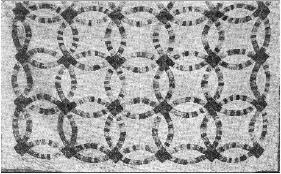
About a year after the McKim design was published in the Kansas City Star, the design was illustrated in Indiana Farmer's Guide (Huntington, IN), ca. November 1929. Identified as Double Wedding Ring, Rainbow, or Around the World, the unknown writer or columnist told readers that "the picture was taken of a quilt made over a century ago, although many people believe this to be a late design in quilt making." (The "unknown writer" is believed to be Carlie Sexton although she was never identified in either Indiana Farmer's Guide or in Rural New Yorker that published quilt designs from the same source, including many of Carlie Sexton's photographs and images.)
But wait, I can hear you saying that the Ladies' Art Company in St. Louis also published the Double Wedding Ring in 1928--it's in their catalog identified with a 1928 copyright notation. Yes, that is true. However, what is not generally known is that two different editions of the 1928 catalog were published. The first edition lists 510 designs, but the Double Wedding Ring is No. 512 in the next edition with 530 designs. Evidence has not been located to indicate just when the revised edition was released but is believed to have been prior to 1933-1934 when an auxiliary catalog, Catalog of . . . Quilts and Quilting, was published with seven additional patterns numbered 531 through 537.
The Kansas City Star published a lengthy article, "History in Old Quilts," April 1, 1930, describing an event held the previous day at the Kansas City Art Institute that "included an exhibition and lecture on the art of quilt-making." Among the more than 200 quilts displayed were "the double nine patch, the Irish chain and several versions of 'The Double Wedding Ring.'"
Late in 1930, Carlie Sexton wrote: "The Double Wedding Ring has many names--the Rainbow, Around the World, King Tut are some of the names. It is not a new pattern, however, as some are inclined to think, for one of my readers asked me about the pattern a long time ago and said they had an old quilt of this pattern but could not cut the pattern off. Then all at once, like an epidemic, they were being made all over the country." Quoted from Yesterday's Quilts in Homes of Today (Des Moines, IA: Meredith Publishing Co., 1930), 12. The book was first advertised in Successful Farming, February 1931.
Then the flood gates opened in 1931 with a dozen or so publications illustrating the Double Wedding Ring and selling its pattern--Successful Farming, the Mountain Mist batting wrappers (pattern 21 ©1931), Woman's World, Nebraska Farmer, Missouri Ruralist, Grandmother Clark in St. Louis, Needlecraft, the Magazine of Home Arts, Anne Orr in Good Housekeeping, Farmer's Wife, the Helen Kaufman syndicated column from Chicago, Household's Quilt Block Service located in the Capper publications building in Topeka, Kansas, and finally Aunt Martha. With the exception of Needlecraft and Anne Orr, these are all midwestern writers, publications, and businesses.
Woman's World (Walter Manning, Chicago) said it was "adapted from a very old pieced patchwork pattern which was frequently found in a bride's linen chest" when they published it in their January 1931 issue.
Anne Orr wrote much the same as the earlier writers in her Good Housekeeping column, July 1931: "The Double Wedding Ring, an adaptation of an old pattern."
If it was such common knowledge in 1928-1931 that the Double Wedding Ring was an "old pattern," then where are the quilts that support the claim? A few quilts are known, but very few, several of which have debatable date attributions primarily because they are made in solid colors. I'm proud to say that among these few quilts is a calico quilt in my personal collection found in the Dodge City, Kansas, area made with a variety of 1880s-90s calicos but sadly nothing else is known about it.
19th Century and Early 20th Century DWR Quilts
Mary Elizabeth Johnson Huff illustrates a Double Wedding Ring quilt on page 40 in Alabama Quilts; Wilderness through World II, 1682--1950 (Jackson, MS: University Press of Mississippi, 2020) that she dates to circa 1850-1875. Made in solid colors, indigo blue, chestnut brown, red, and white by Melvina James Peters as a wedding gift for her daughter.
Perhaps the Double Wedding Ring quilt discussed most often resides in the Baltimore Museum of Art collection attributed to ca. 1870, gift of Dr. William Rush Dunton, but a good quality color photograph of it is not known. It appears to be constructed with a variety of pastel solid colors with navy or similar dark color on a tan or cream ground. A small black and white detail is in Quilter's Newsletter Magazine, 108 (January 1979):26, reprinted from The Great American Cover-Up: Counterpanes of the Eighteenth and Nineteenth Centuries (Baltimore, MD: Baltimore Museum of Art, 1971), 36, and a poor quality color photograph of roughly half the quilt is in "Craze for Quilts," Life Magazine (May 5, 1972):76.
(The Life photograph will be illustrated here when I find my copy of this issue.)
The documentation records, including notes, for the ca. 1890 utilitarian Texas quilt in Karoline Patterson Bresenhan and Nancy O'Bryant Puentes, Lone Stars: A Legacy of Texas Quilts, 1836-1936 (Austin: University of Texas Press), 106-07, are now available in The Quilt Index (http://www.quiltindex.org/search.php). Specify tqs_0042 for ID Number and choose Texas Quilt Search for Project/Collection. The family's tradition has that the quilt was made by Edna Sweeten after she moved to Texas in 1896, and the documentor dated the quilt 1876-1900 / ca. 1890.
The Texas Heritage Quilt Society illustrates a calico quilt attributed to ca. 1890 in Texas Quilts, Texas Treasures (Paducah, KY: American Quilter's Society, 1986) on page 68. It was a wedding gift, September 20, 1916, from the groom's mother who made a quilt for each of her nine sons. This family's history combined with the quilt's calicos provide better clues to the age of this quilt as opposed to the first two quilts with their solid colors. Unfortunately a detail is not included with the photograph of the entire quilt which is not the best quality for study, and this project's documentation records are not yet in The Quilt Index. An eight-pointed star replaces the usual four patch where the rings intersect.
Merikay Waldvogel discovered a DWR quilt in 1990 that was made in Georgia around 1900. The family has always known it as Tangled Love but further details are not available.
Dated 1909-1910 and thoroughly documented on the surface of the quilt with an embroidered statement, another Georgia quilt was documented by the Georgia Quilt Project. Known as Diamond Ring by the family, it's illustrated on page 169 of Anita Zaleski Weinraub, ed., Georgia Quilts: Piecing Together A History (Athens, GA: Univ. of Georgia Press, 2006).
Another Georgia quilt found in north Georgia about 20 years ago and said to have been made by a black lady. (https://www.facebook.com/photo?fbid=7310123889060041&set=gm.3210937272528936)
Dolores A. Hinson, in her article, "Quilts: Variations on a Theme," for Antiques Journal September 1973):22-24, says of the Double Wedding Ring: "The last set of pattern variations are not old at all, since the pattern dates only from the early years of the 20th century. This pattern is so popular and so many quilts have been made from it that many people do not realize that this pattern is not really old enough to provide us with any antique examples." Jonathan Holstein voiced similar sentiments in Quilter's Newsletter Magazine 105 (September 1978):17.
In January 1979, Nellie McWhirter of Goodwell, Oklahoma, wrote Edna Paris Ford in Louisville, Kentucky: "Yes, I agree with you the 'Double Wedding Ring' is an old pattern. It did not become very popular here until the '30's when it was printed in a farm paper, (which said it was copied from an old, old pattern). All of us pieced it, not so much on account of its beauty but because it used small scraps. Little scrap[s] were all that we had, at that time, and we were tired of piecing 'String quilts'." [Original letter courtesy Mrs. Ford's daughter.]
Another Hypothesis
Did the Double Wedding Ring design become a quiltmaking fad in the midwest during the 1920s which in turn caused the design to finally be published in October 1928, then spread to eastern and western states? As quoted earlier, Carlie Sexton seems to suggest this when she wrote in 1930, "Then all at once, like an epidemic, they were being made all over the country." Linda Northway Kosfeld also put forth this possibility in Minnesota Quilts: Creating Connections with Our Past (St. Paul, MN: Voyageur Press, 2005) writing on page 136 that "it was undoubtedly [a pattern] that quiltmakers shared among themselves long before it was published in Capper's."
A search of NewspaperArchive.com for the phrase, wedding ring quilt, in all available newspapers world-wide, ranging 1700-1930, produced twenty-eight results beginning July 1, 1928--one each in Ohio, Arkansas, Texas, and Illinois newspapers, with the remaining twenty-four in Missouri newspapers. The search also revealed that the design was more often referred to as Wedding Ring than as Double Wedding Ring during the earliest years of its popularity. These results are also interesting considering that the company responsible for NewspaperArchive is based in Des Moines, Iowa, and therefore has more Iowa newspapers online than for any other state.
The first mention of the name was four months before the Capper's Weekly and Kansas City Star illustrations: "Mrs. Frank Stokes, 913 West Second street, entertained the W. R. C. Club Tuesday [Women's Relief Corp]. A covered dish luncheon was enjoyed at noon. The afternoon was spent at work on a 'wedding ring' quilt. Fourteen members were present." Quoted from the Joplin (MO) Globe, July 1, 1928.
The next mention of the design is in a general newspaper article four months after the Capper's Weekly and Kansas City Star illustrations: "The wedding ring quilt craze has hit town and the housewife who is not quilting is not in style. One firm reported selling several hundreds of pounds of the pretty little pieces of material for the rings. It takes seven yards for the backing, then comes the filling, thread, something to eat for the neighbors who have come in to help, then the pleasant, newsy conversation that flows back and forth over the quilting frames. The cold weather was good for something." Quoted from the Neosho (MO) Daily Democrat, February 26, 1929, and reprinted from the Higginsville (MO) Jeffersonian, date unknown.
The 1929 article's reference to one of the many businesses that sold packages of quilt pieces and the specific reference, "little pieces of material for the rings," combined with the 1928 article, both in Missouri newspapers, suggests that the DWR was already popular before the design was illustrated towards the end of 1928, that it may have originated in the midwest, specifically in Missouri, and underscores our questions, "Where did this design come from?" and "How was it disseminated?"
Pine Burr aka Pickle Dish or Indian Wedding Ring
It has been speculated that a similar design with a 19th century history and made with tiny triangles instead of rectangular wedges might have been the progenitor of the Double Wedding Ring. Known as Pickle Dish or Indian Wedding Ring today, the earliest known illustrations of this design were published in 1931 as Pickle Dish by Eveline Foland in the Kansas City Star, October 24, 1931 (shown on the left), and by Prairie Farmer in their quilt pattern booklet attributed to 1931 (see separate page for Mrs. Grace Jones). Eveline Foland wrote that "it is an old Virginia pattern," and Mrs. Jones said it is "similar to the Double Wedding Ring except that it is of two colors."
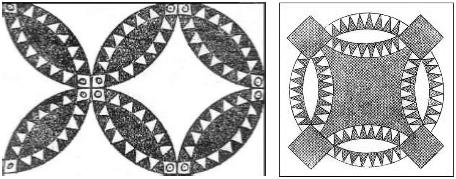
In the next pair of images, Grandmother Clark's Indian Wedding Ring from Book 23, ©1932, is shown on the left, and Home Art Studios 305 Indian Wedding Ring on the right. (Home Art Studios attributed their 314 Pickle Dish to Virginia as did Eveline Foland but based their engraving on Grandmother Clark's Indian Wedding Ring engraving.) Nancy Cabot's Indian Wedding Ring was illustrated in the Chicago Tribune, December 16, 1933, saying it was first known as Burr, possibly, she wrote, in honor of Aaron Burr, but this name's true source will be revealed in the paragraphs that follow.
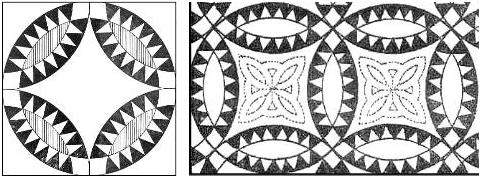
There are currently ten Pickle Dish quilts attributed to ca. 1870-1900 available for study in The Quilt Index (http://www.quiltindex.org/search.php). All but one have a Southern provenance and seven of these were documented in Tennessee. There's also an extraordinary "Ind. Wedding Ring" documented by the Louisiana Project, an example of the most intricate of the quilts from this group of designs made with a double row of tiny triangles in each segment. Enter 1948 for ID Number and choose Louisiana Regional Folklife Program for Contributor/Institution. The Virginia Project records are not yet available in The Quilt Index which may or may not support Eveline Foland's statement in 1931.
Sometimes referred to as Pine Burr, four additional late 19th century Pickle Dish quilts are illustrated by the Texas Heritage Quilt Society in Texas Quilts, Texas Treasures (Paducah, KY: American Quilter's Society, 1986), pages 32, 58, 78, and 88. (This book also illustrates the early 20th century calico DWR quilt on page 68 that was discussed earlier.)
Another Pine Burr / Pickle Dish quilt is in the collection of the DAR Museum in Washington, DC. Made in Alabama, it is ID number 89.17 in The Quilt Index.
As the pages are turned in books that illustrate primarily Southern quilts, especially quilts from Georgia to Texas, a common design element emerges--rows of tiny triangles worked into design after design, whether in straight lines or in curved designs, and commonly seen in sashings and in borders. Mary Elizabeth Johnson refers to these collectively as "Feathered Edges" in Mississippi Quilts (Jackson, MS: University Press of Mississippi, 2001), page 80: "A 'sawtooth' edge, pieced of light and dark triangles, that adds interest to many designs is also known as a 'feathered' edge. Piecing the triangles . . . is a tedious procedure, especially when the feathering must be shaped around a curve . . . [and was often] made of two different sizes."
Family heirlooms and traditions unquestionably accompanied families as they moved westward across the South into Texas (my own ancestors included). Is it possible that the intricate design they had known as Pine Burr was later simplified into the Double Wedding Ring? Then for whatever reason it became a fad and began its infamous spread from state to state? How does anyone explain how, when, where, or why any fad begins?
The Ladies' Art Company in St. Louis, Missouri, included an unusual Pickle Dish design as Number 81 in their earliest catalog in 1895-1897 but the source for their design is not known.
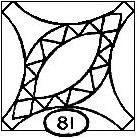
The most intriguing variation of the Pickle Dish or Indian Wedding Ring (illustrated on the left) was published by Capper's Weekly (Arthur Capper, Topeka, KS), January 31, 1931. It was named "When Circles Get Together" and attributed to Godey's Lady's Book "away back in the middle of the 19th century" but this design has not been located in Godey's. Instead, the unnamed "Patchwork" design shown on the right from the December 1857 issue is the only Godey's design that remotely resembles the Capper's Weekly design. It's difficult to visualize that the intricate Capper's design was configured from this Godey's design. Perhaps the Capper's editor had a page from a different periodical that she thought was from Godey's but was actually from another unknown magazine that has yet to be identified?

Wilma Smith in Oregon included an engraving of a design called Scuppernong Hull in her 1970s self-published book, Quilt Designs From Hearth and Home. However, this engraving was not published in Hearth and Home or in any of its four sister papers. Instead, it might be from Comfort (Gannett, Augusta, ME), but the name suggests that it was more likely published in a Southern farm paper where the name would have been more familiar than in the North. It is one that I have long searched for as it, too, might be an early published example of a predecessor to the DWR. (I preserved the original caption with the engraving as it will verify the published source once it is located. It reads: "Scuppernong Hull Quilt Block. Pieced Out of Black and White.")
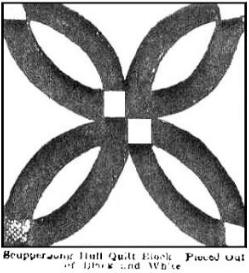
Scuppernong is a grape from the muscadine family first found on the Outer Banks of North Carolina which is why the engraving was probably taken from a Southern magazine and why the engraving has been difficult to identify (vintage quilt pattern collections by Southern quiltmakers are not as plentiful as similar collections from their Northern sisters). There are currently four wedding ring quilts identified with the Scuppernong name in The Quilt Index--two vintage quilts recorded in Louisiana and two newer quilts in Wyoming.
The Popularity of the Double Wedding Ring Grows
Did the increased availability of the Double Wedding Ring pattern in 1931 contribute to its spread beyond the midwest? Repeating the NewspaperArchive.com search for the phrase, wedding ring quilt, in all available newspapers world-wide but restricting the search to the year 1931, produced forty-three results that added newspapers in Iowa, Pennsylvania, Indiana, Colorado, Kansas, Oklahoma, and California to the five states where the design had been mentioned in 1928, 1929, and 1930.
Missouri quiltmakers had produced so many Double Wedding Ring quilts by the end of 1931 that the design earned a separate category for "best wedding ring quilt" among the fifteen judged classes in a quilt show sponsored by the P.T.A. in Parkville, Missouri. The categories included the oldest quilt (1776), the quilt with the most pieces (10,557), applique, and child's quilt, among others. "From One P. T. A. to Another," in The Farmer's Wife (February 1932):25.
As we struggle to find the answer to our questions about the Double Wedding Ring, we are reminded that another difficult quilt pattern, Grandmother's Flower Garden, was equally popular alongside the DWR. It was estimated in 1932 "that no less than two hundred of this special pattern [Grandmother's Flower Garden] are being made in Ruston [Louisiana] and vicinity." Quoted from the Ruston Daily Leader, October 22, 1932.
I was a documentor for the Kansas Quilt Project in 1986, and one of the conversations we shared amongst ourselves centered around the answers we received to the question, "Why was the quilt made?" We observed time and again that the younger generation would answer, "out of necessity," or "for warmth," or words to that effect, while the older generation, often the quiltmaker herself, would answer, "for entertainment." This last answer might explain why such difficult, time intensive patterns were made during the 1930s and 1940s decades--to take the maker's mind away from the hardships of the time. Just one year after the Capper's Weekly and Kansas City Star publications of the Double Wedding Ring design, the country was plunged into a decade long Depression.
And so the search continues for 19th century and early 20th century published engravings and the quilts made from them. Perhaps the mystery of the Double Wedding Ring will someday be solved through documentation rather than by speculation based on clues.
page under construction, please check back soon
© Wilene Smith, October 7, 2010 (updated December 1, 2020), all rights reserved